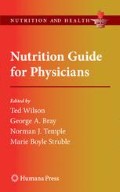Key Points
-
Exclusive breastfeeding is recommended for the first 6 months of life.
-
Formula feeding is only recommended to mothers who cannot or choose not to breastfeed.
-
Breast milk has a degree of bioactivity, antioxidant ability, immunological defenses, minerals, and fatty acids not yet found in formula. These lacking elements may help explain the health benefits associated with breast milk. Formula manufacturers are trying to introduce these missing elements into formula.
-
Complementary feeding should begin at 6 months of age with breast milk continuing until at least 1 year of age.
-
Complementary feeding should help promote a positive association with hunger, food, appetite, and the person feeding. Infants should also learn gross motor skills and form relationships.
Access this chapter
Tax calculation will be finalised at checkout
Purchases are for personal use only
Suggested Further Reading
Dewey KG. What is the optimal age for introduction of complementary foods? Nestlé Nutrition Workshop Series. Pediatric Program 2006; 58:161–170; discussion 170–175.
References
American Academy of Pediatrics. Breastfeeding and the use of human milk. Pediatrics 1997; 100:1035–1039.
Canadian Paediatric Society, Dieticians of Canada, Health Canada. Nutrition for Healthy Term Infants. Minister of Public Works and Government Services, Ottawa, 1998.
American Academy of Pediatrics. The use of whole cow’s milk in infancy. Pediatrics 1992; 89:1105–1107.
Fomon SJ. Recommendations for feeding normal infants. In: Nutrition of Normal Infants. Mosby, St. Louis, 1993, pp. 455–458.
Jenkins DJA, Wolever TMS, Vinson U, et al. Nibbling vs. gorging: metabolic advantages of increased meal frequency. N Engl J Med 1989; 321:929–934.
Lonnerdal B, Atkinson S. Nitrogenous components of milk. A. Human milk proteins. In: Jensen UG, ed. Handbook of Milk Composition. Academic Press, San Diego, 1995, pp. 351–368.
Redenials WAN, Chen Z-Y. Trans, n-2, and n-6 fatty acids in Canadian human milk. Lipids 1996; 31:5279–5282.
Friel JK, Longerich H, Jackson S, Dawson B, Sutrahdar B. Ultra trace elements in human milk from premature and term infants. Biol Tr Elem Res 1999; 67:225-247.
Lonnerdal B. Regulation of mineral and trace elements in human milk: exogenous and endogenous factors. Nutr Rev 2000; 58:223–229.
Friel JK, Bessie JC, Belkhode SL, et al. Thiamine, riboflavin, pyridoxine, and vitamin C status in premature infants receiving parenteral and enteral nutrition. J Pediatr Gastroenterol Nutr 2001; 33:64–69.
Fomon SJ, Straus UG. Nutrient deficiencies in breast-fed infants. N Engl J Med 1978; 299:355–357.
Friel JK, Aziz K, Andrews WL, Harding SV, Courage ML, Adams RJ. A double-masked, randomized control trial of iron supplementation in early infancy in healthy term breast-fed infants. J Pediatr 2003; 143:582–586.
Nelson SE, Ziegler EE, Copeland AM, Edwards BB, Fomon SJ. Lack of adverse reaction to iron-fortified formula. Pediatrics1988; 81:360–364.
Lonnerdal B. Breast milk: A truly functional food. Nutrition 2000; 16:509–511.
Hamosh M. Enzymes in human milk. In: Jensen UG ed. Handbook of Milk Composition. Academic Press, San Diego, CA, 1995, pp. 388–427.
L’Abbe MR, Friel JK. Enzymes in human milk. In: Huang V-S, Sinclair A, eds. Recent Advances in the Role of Lipids in Infant Nutrition. AOCS Press, Champaign, IL, 1998, pp. 133–147.
Mennella JA, Jagnow CP, Beauchamp GK. Prenatal and postnatal flavor learning by human infants. Pediatrics 2001; 107:E88.
Weaver LT, Lalver MF, Nelson R. Intestinal permeability in the newborn. Arch Dis Child 1984; 59:236–241.
Buescher ES, McIllherhan SM. Antioxidant properties of human colostrum. Pediatr Res 1988; 24:14–19.
Friel JK, Martin SM, Langdon M, Herzberg G, Buettner GR. Human milk provides better antioxidant protection than does infant formula. Pediatr Res 2002; 51:612–618.
Dewey KG, Heinig MJ, Nommsen-Rivers LA. Differences in morbidity between breast-fed and formula-fed infants. J Pediatr 1995; 126:696–702.
Heinig, MJ, Dewey KG. Health advantage of breast feeding for infants: A critical review. Nutr Res Rev 1996; 9:89–97.
Friel JK, Andrews WL, Simmons BS, Mercer C, Macdonald A, McCloy U. An evaluation of full-term infants fed on evaporated milk formula. Acta Paediatr 1997; 86:448–453.
Courage ML, McCloy UR, Herzberg GR, et al. Visual acuity development and fatty acid composition of erythrocytes in full-term infants fed breast milk, commercial formula, or evaporated milk. J Dev Behav Paediatr 1997; 19:9–17.
Lucas A, Morley R, Cole TJ, Lister G, Leeson-Payne C. Breast milk and subsequent intelligence quotient in children born preterm. Lancet 1992; 339:261–264.
Dewey KG, Cohen RJ, Brown KH, Rivera LL. Effects of exclusive breast feeding for four versus six months on maternal nutritional status and infant motor development. J Nutr 2001; 131:262–267.
World Health Organization. Complementary Feeding. Report of the Global Consultation, and Summary of Guiding Principles for Complementary Feeding of the Breastfed Child. WHO, Geneva, 2003. Available at: http://www.who.int/child_adolescent_health/documents/924154614X/en/index.html. Last accessed November 26, 2008.
Krebs NF. Meat as an early complementary food for infants: implications for macro- and micronutrient intakes. Nestlé Nutrition Workshop Series. Pediatric Program. Denver, Colorado 2007; 60:221–229.
Fox MK, Pac S, Devaney B, Jankowski L. Feeding infants and toddlers study: What foods are infants and toddlers eating? J Am Diet Assoc 2004; 104:S22–S30.
Agostoni C, Riva E, Giovannini M. Complementary food: international comparison on protein and energy requirement/intakes. Nestlé Nutrition Workshop Series. Pediatric Program 2006; 58:147–156.
Author information
Authors and Affiliations
Editor information
Editors and Affiliations
Rights and permissions
Copyright information
© 2010 Humana Press, a part of Springer Science+Business Media, LLC
About this chapter
Cite this chapter
Rorabaugh, J.M., Friel, J.K. (2010). Infants: Transition from Breast to Bottle to Solids. In: Wilson, T., Bray, G., Temple, N., Struble, M. (eds) Nutrition Guide for Physicians. Nutrition and Health. Humana Press. https://doi.org/10.1007/978-1-60327-431-9_16
Download citation
DOI: https://doi.org/10.1007/978-1-60327-431-9_16
Published:
Publisher Name: Humana Press
Print ISBN: 978-1-60327-430-2
Online ISBN: 978-1-60327-431-9
eBook Packages: MedicineMedicine (R0)

